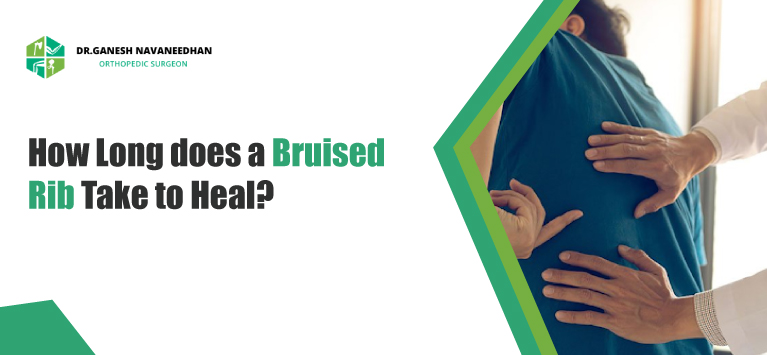- +91 62384 78716 +91 99475 78797
-
Sasthamangalam, Trivandrum
Sasthamangalam, Trivandrum

Have you recently experienced the discomfort of a bruised rib? It can be painful and leave you wondering, “How long does it take for a bruised rib to heal?” Limiting motion and gradually increasing it are necessary for rib bruise recovery. It’s crucial to have a doctor check any rib injury to make sure it’s not severe and hasn’t harmed internal organs. This blog will explore the factors influencing the healing time and provide insights into managing the recovery process.
Your ribs might be thin, but they play a crucial role in protecting your lungs, heart, and chest cavity. If you face an injury to your chest, it could lead to bruising, cracking, or fracturing of one or more ribs. A bruised rib occurs when the blood vessels around the ribcage are damaged due to impact or injury. This can result from accidents, falls, or even intense coughing.
It can be hard to distinguish between a bruised and a broken rib since they share similar symptoms, which may include:
A bruised rib often presents with notable pain and tenderness around the injured area. Pain may increase with movement or pressure on the bruised rib.
Visible signs like bruising and swelling can accompany a bruised rib. Observe changes in colour and size of bruises and swelling to track healing progress.
Breathing difficulties may arise due to the pain associated with rib movement. Pay attention to any restrictions or pain during deep breaths.
Discomfort is often localized to the injured rib area. Identifying the specific location of pain aids in targeted care.
Are you navigating these symptoms? Connect with your healthcare professional for personalized guidance. Your well-being matters, and learning the healing process helps you to manage it effectively.
Are you curious about what influences the healing time of a bruised rib? Here, we have delved into it:
The extent of the bruise plays a crucial role in determining the recovery period. Mild bruises heal faster compared to more severe injuries.
Each person’s body responds differently to injuries. Age, health, and pre-existing conditions can influence how quickly a bruised rib heals.
Seeking medical advice can contribute to a speedier recovery. A healthcare professional can provide recommendations for pain management and monitor your progress.
Are you experiencing the same? Your doctor is your best guide for personalized advice. Understanding these influences empowers you to manage your recovery effectively.
While individual experiences may vary, a general timeline for healing can be outlined:
During the initial week, pain and discomfort are typically at their peak. Rest, ice packs, and pain relievers are recommended to manage symptoms.
Significant improvement is often observed during the second week. Bruising may start to fade, and the pain gradually decreases.
By the third week, many individuals experience substantial relief. However, complete healing may take several weeks, and avoiding activities that strain the ribcage is crucial.
Here are some methods to ease pain and discomfort during your recovery:
Make room for your body and the time it requires to heal. Avoid activities that exacerbate pain and strain the injured area.
Over-the-counter pain relievers, as suggested by your doctor, can help manage pain. Applying ice packs during the initial days can also be beneficial.
Engage in light movements and breathing exercises recommended by your healthcare provider. This can prevent stiffness and promote circulation.
Adhere to the guidance offered by your doctor. Make sure to attend your follow-up appointments and share any concerns or changes in symptoms.
Follow the above suggestions to get relief during the healing process.
While most bruised ribs heal with time and proper care, certain signs may indicate a need for medical attention:
Consult your healthcare provider if pain persists or intensifies beyond the expected healing timeline.
Difficulty breathing, chest pain, or persistent coughing should be evaluated promptly.
Watch for signs of infection, such as increasing redness, swelling, or discharge from the bruised area.
If you notice persistent or worsening pain, difficulties in breathing, chest pain, or signs of infection, it’s crucial to seek prompt medical attention.
Healing from a bruised rib is a gradual process that requires patience and proper self-care. While the typical timeline gives an overview, individual variations are common. Listen to your body, follow medical advice, and prioritize your well-being during recovery.
Remember, if you have concerns about your healing progress, feel free to reach out to your healthcare professional for personalized guidance. Your health is a priority, and understanding the healing process empowers you to navigate it effectively.
Copyright © 2025 Dr. Ganesh Navaneedhan. All Rights Reserved. | Designed By Harvee healthcare